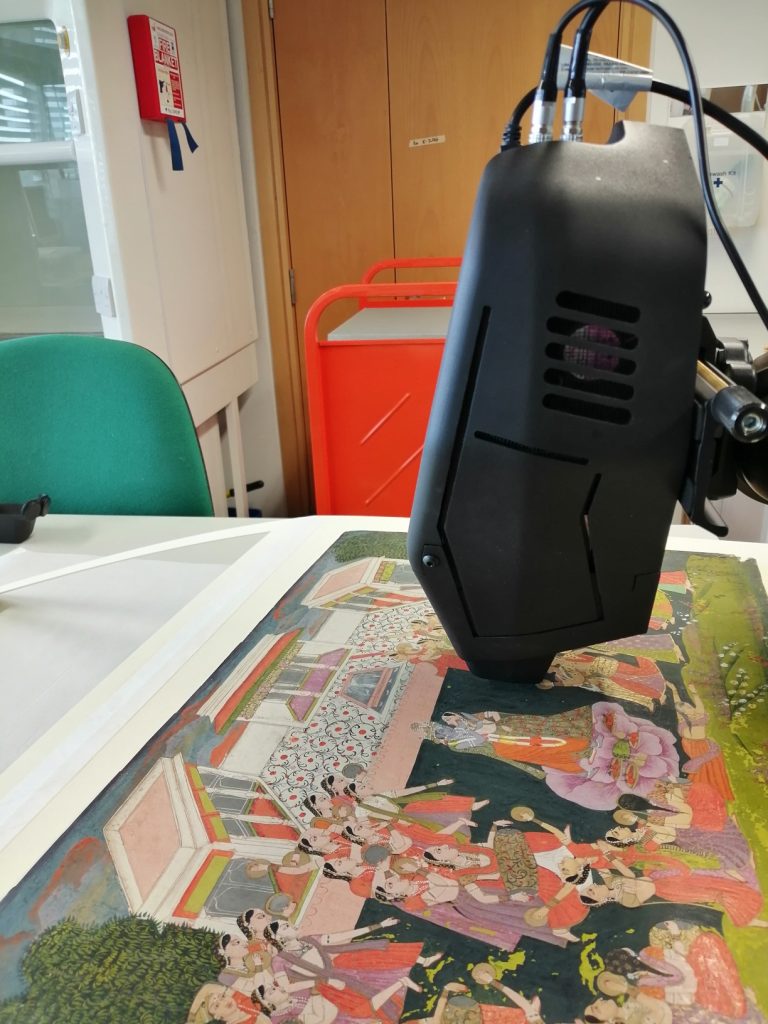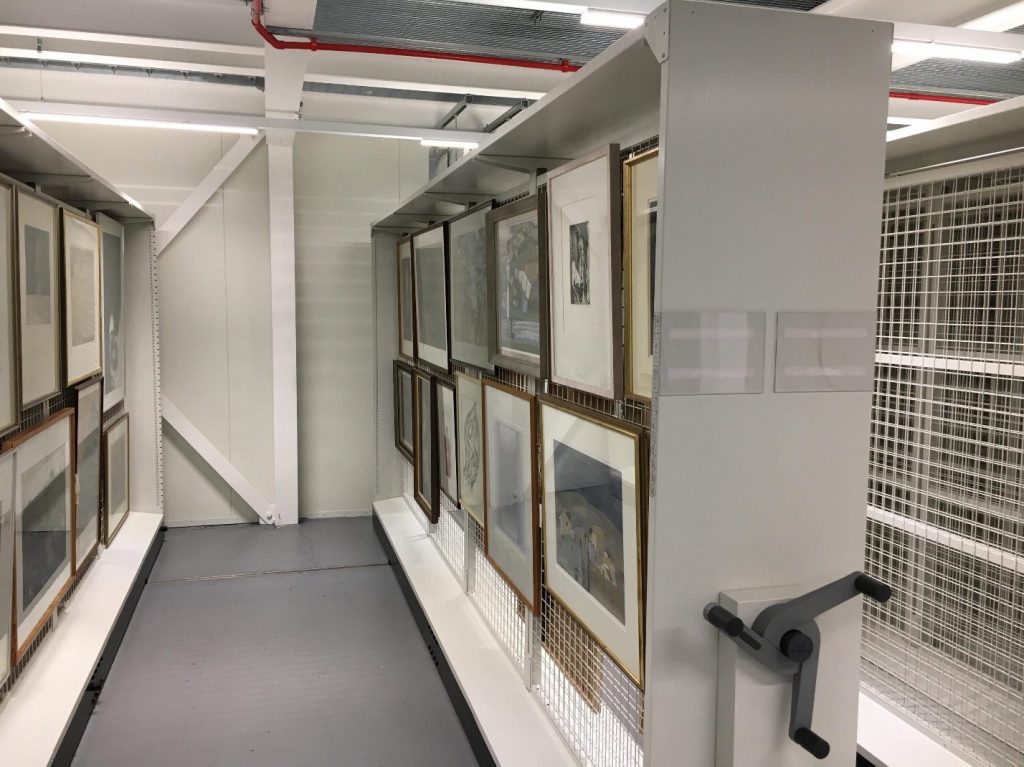A new year and a new blog from the conservation studio! Our first blog of the month comes from Stephanie Graban, an undergraduate student from the University of Edinburgh currently studying Arabic, who volunteered virtually with the conservation team for eight weeks from October to December 2020….
As my time working as a volunteer for the Centre for Research Collections (CRC) comes to an end, I’d like to reflect on my experiences. The eight-week project, which was both challenging and fascinating, focused on XRF analysis and background research of objects held by the University. These included a rare 15th century German Bible, a striking Persian marbled album, vibrant Indian Ragamala paintings, a collection of commemorative medals, and scraps of a 10th century Qur’anic manuscript. Evidently, the range of objects which I studied was wonderfully varied; each week felt like I was embarking on a new historical journey to a different corner of the world – from the comfort of my bedroom. The internship was carried out remotely due to Covid-19 and, although I wish I had the opportunity to see the XRF spectrometer at work, it was all the detective work that made this project so unique and memorable.

XRF analysis of Ragamala painting (Or.Ms.437) carried out by Special Collections Conservator, Emily Hick, at the CRC
My task was to interpret combinations of periodic elements in a table and deduce what pigments these elements could form. I quickly realised that in practice, this could be quite the challenge as the pigments could be contaminated or mixed with neighbouring colours. In order to make a confident assumption about the pigment’s identity, I consulted various pigment databases on the internet, as well as books exploring colours from various time periods and cultures. It was through this process that I found a new dimension to all the colours I see on a daily basis. Before the project, I never thought twice about why my jeans are blue or how the acrylic colours in my painting set were first named. I quickly realised that each colour that we interact with on a daily basis offers a rich and captivating history, which may even be controversial at times.
Taking the example of the Ragamala paintings which I studied in Week 3, I discovered the surprisingly cruel history of Indian Yellow. The pigment, which began to be utilised on a wide scale in the 16th century, was produced by force-feeding bitter mango leaves to cows until they were near the point of starvation. The leaves would intensify the bile pigment and produce bright-yellow urine. The cow urine was then collected and boiled for hours, resulting in a pigment which proved sensational across Asia and Europe! Without a doubt, everyone has seen this haunting pigment in a world-famous work: Van Gogh’s Starry Night – but few people know about its morbid history.

Ragamala painting (Or.Ms.437)
This was not the only secret the Ragamalas hid in plain sight. Upon analysing the elements making up the colours of the vividly-decorated music sheets, I noticed that titanium was overwhelmingly present in the artwork. This did not seem correct. The only recognised use of titanium in paint is in the manufacture of titanium dioxide white, a paint which was only first synthesised in the early 20th century. The presence of titanium is now commonly used as a marker for detecting forgeries. However, the Ragamalas were dated back to 1842 by the University catalogue, which drew questions about its authenticity. How was it possible for titanium white to be used in the object? Was the dating wrong? After delving into literature on similar Ragamala paintings, I came across a study which raised the exact same questions about the presence of titanium. Here I found an interesting observation: the authors of the article suggested that Indian artists may have been using titanium in their paints since the 17th century, centuries before the West first used it. This is a fascinating idea, but it’s a topic yet to be thoroughly explored. However, discovering further evidence which supported this observation offered a sense of importance to our findings.
That wasn’t the only time throughout the project where XRF analysis proved potentially valuable to academic discourse. A Persian album exhibiting calligraphy and marbled paper was chosen for analysis due to uncertainty in its date of manufacture. The catalogue description claims that the marbled page borders were added to the album at a later date and were not contemporary to the construction of the album. While XRF analysis did not offer any decisive results, I was able to find a recent essay by researcher Jake Benson discussing the very same album. Benson offered strong arguments in favour of the marbling being contemporary to the album’s construction.

Persian album of calligraphy and marbled paper – Qit’at-i Khushkhatt (Or.Ms.373)
After conducting contextual research, I found out that the marbled pages were most likely created by the famous marbling master Muhammad Tahir. In fact, the album likely inspired generations of artists, who used Tahir’s methods to endow Persian literary masterpieces such as Conference of the Birds and Fragrant Orchard with similar marbled borders. I reached out to Jake Benson, who kindly offered his suggestions on specific areas to conduct future technical analysis on in the album that would conclusively date the marbled borders. It felt exciting that the potential data gathered by XRF could be used to change what we know about such an important historical object!
The last object which I studied during the project was one of my personal favourites. It consisted of ancient-looking scraps of vellum displaying angular Qur’anic Arabic calligraphy. The University catalogue did not offer much information on its background or dating, so anything I could find while analysing the XRF data and conducting background research could prove valuable. I ultimately managed to date the manuscript scraps to approximately the 10th century, by using clues relating to the style of calligraphy and the format of the manuscript. I also found out that the manuscripts were discovered in the Al-Amr mosque in Egypt, the same mosque which held the oldest Qur’an ever found (now held at the University of Birmingham).

Scrap of vellum with angular Qur’anic Arabic calligraphy (Or.Ms.175)
Perhaps the most valuable outcome for me personally is that the past two months have taught me so much about various areas of history (including the history of colour) which I have never had the opportunity to study formally. The opportunity to solve a new ‘puzzle’ every week and put all the pieces together into a meaningful and valuable interpretation was more rewarding than any other academic project I’ve worked on! Thank you to Special Collections Conservator, Emily Hick, for all your kind guidance and advice throughout the eight weeks and for making my time as a volunteer (especially Thursday afternoons) very memorable. Lastly, thank you to CRC for offering me an invaluable opportunity to gain experience in the field of XRF analysis.
To find out more about volunteering opportunities at the CRC, please see our website. https://www.ed.ac.uk/information-services/library-museum-gallery/crc/volunteers-interns-honorary-fellows/volunteers-interns











